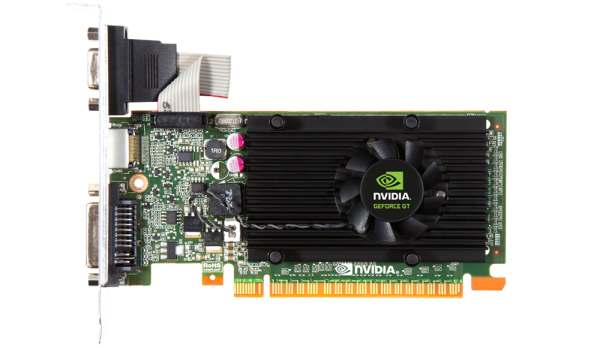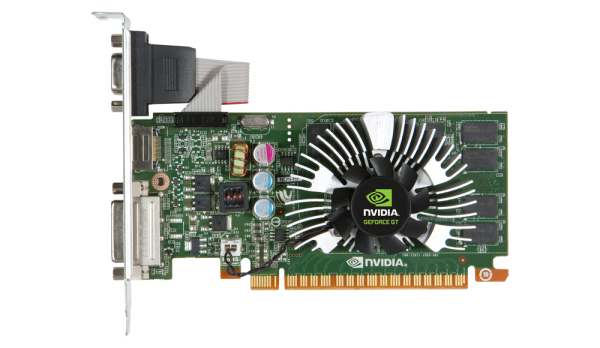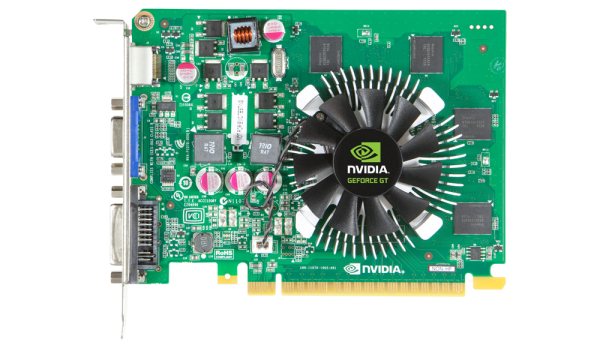NVIDIA Launches Fermi Based GeForce GT 610, GT 620, GT 630 Into Retail
by Ryan Smith on May 19, 2012 8:00 PM ESTWhile we were off at NVIDIA’s GTC 2012 conference seeing NVIDIA’s latest professional products, NVIDIA’s GeForce group was busy with some launches of their own. The company has quietly launched the GeForce GT 610, GT 620, and GT 630 into the retail market. Unfortunately these are not the Kepler GeForce cards you were probably looking for.
| GT 630 GDDR5 | GT 630 DDR3 | GT 620 | GT 610 | |
| Previous Model Number | GT 440 GDDR5 | GT 440 DDR3 | N/A | GT 520 |
| Stream Processors | 96 | 96 | 96 | 48 |
| Texture Units | 16 | 16 | 16 | 8 |
| ROPs | 4 | 4 | 4 | 4 |
| Core Clock | 810MHz | 810MHz | 700MHz | 810MHz |
| Shader Clock | 1620MHz | 1620MHz | 1400MHz | 1620MHz |
| Memory Clock | 3.2GHz GDDR5 | 1.8GHz DDR3 | 1.8GHz DDR3 | 1.8GHz DDR3 |
| Memory Bus Width | 128-bit | 128-bit | 64-bit | 64-bit |
| Frame Buffer | 1GB | 1GB | 1GB | 1GB |
| GPU | GF108 | GF108 | GF108/GF117? | GF119 |
| TDP | 65W | 65W | 49W | 29W |
| Manufacturing Process | TSMC 40nm | TSMC 40nm | TSMC 40nm | TSMC 40nm |
As NVIDIA was already reusing Fermi GPUs for GeForce 600 series parts for the OEM laptop and desktop market, it was only a matter of time until this came over to the retail market, and that’s exactly what has happened. The GT 610, GT 620, and GT 630 are all based on Fermi GPUs, and in fact 2 of them are straight-up rebadges of existing GeForce 400 and 500 series cards. Worse, they’re not even consistent with their OEM counterparts – the OEM GT 620 and GT 630 are based off of different chips and specs entirely.
At the bottom of the 600 series retail stack is the GeForce GT 610, which is a rebadge of the GT 520. This means it’s either a GF119 GPU or cut-down GF108 GPU featuring a meager 48 CUDA Cores and a 64bit memory bus, albeit with a low 29W TDP as a result. This is truly a rock bottom card meant to be a cheap as possible upgrade for older computers, as even an Ivy Bridge HD4000 iGPU should be able to handily surpass it.
The second card is the GT 620, which is a variant of the OEM-only GT 530. With 96 CUDA cores we’re not 100% sure that this is GF108 as opposed to the 28nm GK117, but as NVIDIA currently has a 28nm capacity bottleneck we can’t see them placing valuable 28nm chips in low-end retail cards. Furthermore the 49W TDP perfectly matches the GF108 based GT 530. Compared to the OEM GT 620 the retail model has twice as many CUDA cores, so it has twice as much shader performance on paper, but because of the 64bit memory bus it’s going to be significantly memory bandwidth starved.
The final new 600 series card is the GT 630, which is a rebadge of the GT 440. Like the GT 440 this card comes in two variants, a model with DDR3 and a model with GDDR5. Both models are based on GF108 and have all 96 CUDA cores enabled, and have the same core clock of 810MHz. At the same time this is going to be the card that deviates from its OEM counterpart the most. The OEM GT 630 was a Kepler GK107 card, so this rules out getting a Kepler based GT 630 retail card any time in the near future.
As always, rebadging doesn’t suddenly make a good card bad – or vice versa – but it’s disappointing to once again see this mess transition over to the retail market. We hold to our belief that previous generation products are perfectly acceptable as they were, and that the desire to have yearly product numbers in an industry that is approaching 2 year product cycles is silly at its best, and confusing at its worst.













44 Comments
View All Comments
dagamer34 - Saturday, May 19, 2012 - link
Gotta love the classic rebadging of old products!StevoLincolnite - Sunday, May 20, 2012 - link
Lots of reasons to do it though, like being supply constrained at 28nm, 28nm being more expensive than the old mature 40nm etc'.But the least they could have done was put faster memory (GDDR5?) on all the cards or something and had passive coolers.
DanNeely - Sunday, May 20, 2012 - link
The margins on very low end cards are too low to pay for GDDR5.CeriseCogburn - Saturday, May 26, 2012 - link
8 out of 10 systems cracked open have a single empty PCI-E card slot.Despite the constant moaning hatred, nVidia knows what it's doing, and these cheap cards are an upgrade boon for almost all those 8 systems with their crud integrated.
So for very cheap and cheaper than that soon if not sooner, usually the only thing that polls well around here, $40 bucks and many tens of millions would suddenly have a "gamable" system, where formerly there was none.
nVidia knows what it's doing, and it's a great thing to do, for millions.
I hope their marketing is HUGE on these, so we can increase the PC gamer user base which will help all of us.
Of course, others are more interested in destroying nVidia and not welcoming gamers into the fold, but dissing and denying instead, and calling them stupid.
No wonder they say PC gaming is going down.
UltraTech79 - Monday, June 4, 2012 - link
Gamers do not buy cards like this. Millions? Who are you kidding? When you can find a GTX 460 on ebay for around $60, these cards are for idiots only.DerKaleun - Sunday, July 29, 2012 - link
idiots.. Yeah, you see... Since you seem to have a very narrow train of thought, let's ignore the obvious other facts. Not everyone can also afford a new PSU. Not everyone has a good CPU to even support games that could be played with it. Jesus, what does it take to get people to use their brain.. "gamers don't buy cards like this." Correction, people that don't feel like being total nerds and spending lots of money buy cards like this. "LOL BUT YOU CAN GET IT OFF EBAY!!!!!11" Sure, I suppose you could. I also assume it's OEM right? No warranty, nothing like that. I don't know about other people, but I sure as hell don't trust something with such a major price difference, let alone that coming from eBay. Even then, you will only ever find it that low on eBay, after looking on Amazon, NewEgg and Tiger Direct. I have won, any further arguments from you will be invalidated. One more win for me.MySchizoBuddy - Sunday, May 20, 2012 - link
What happens once 28nm becomes mature. will the same cards all of a sudden come with kepler or Nvidia will lauch an entire set of even more confusing names.MrSpadge - Monday, May 21, 2012 - link
They'll long be in the 7000 or 8000 generation by then, featuring still the same Kepler chips we're seeing today, plus (maybe) some new ones.tipoo - Tuesday, May 22, 2012 - link
The high end cards would be on the next architecture by then and the low end cards would start using a cut down Kepler no doubt.CeriseCogburn - Saturday, May 26, 2012 - link
What happens then is 10's of millions of more gamers are added to our ranks so we can get moar and better PC games faster.Yes, it's just a terrible, terrible thing that is happening. It's aweful.